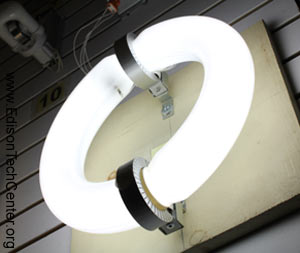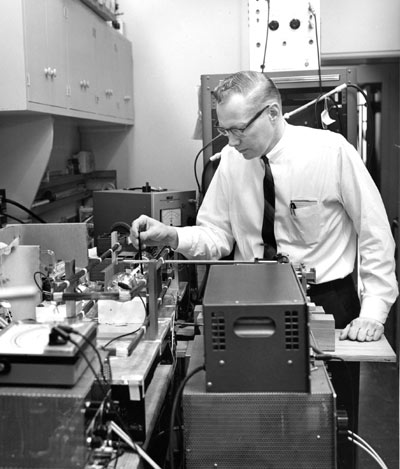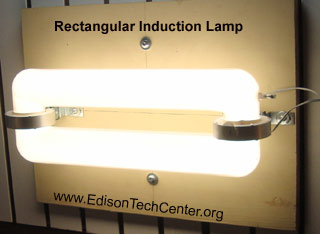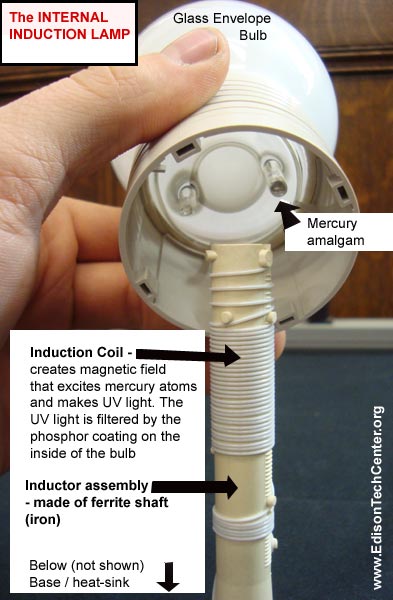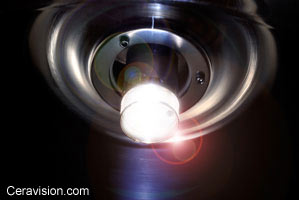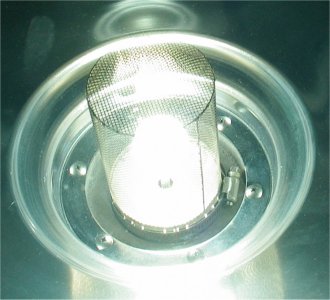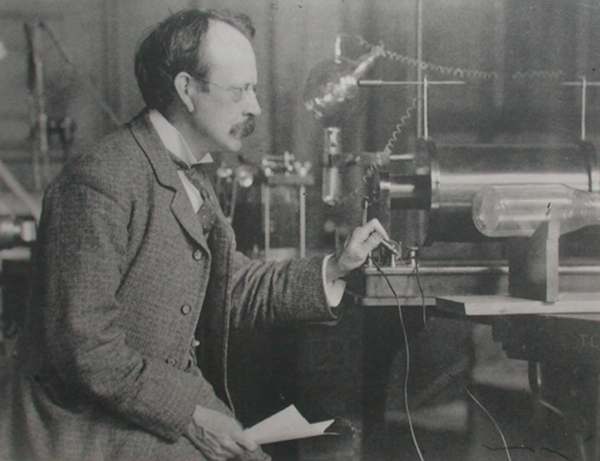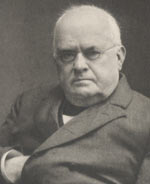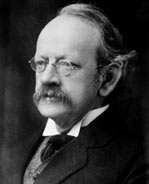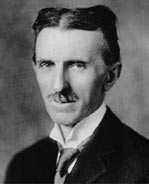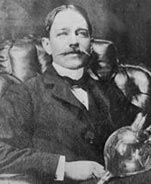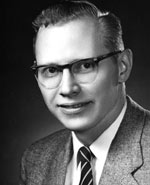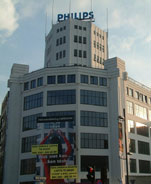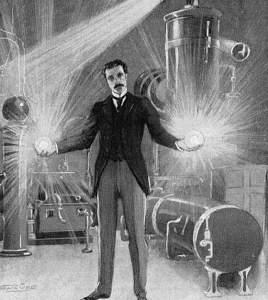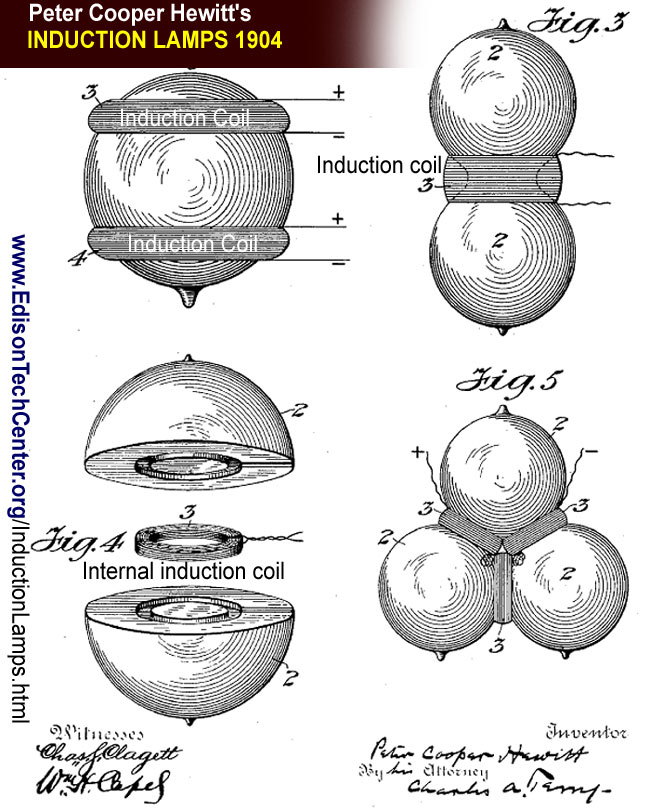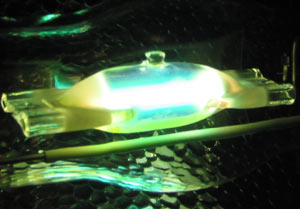Induction Lamps
Electrodeless Fluorescent Lamps
1990s - Today
Introduction & Statistics
HEP Lamps
How They Work
Sulfur Lamps
Inventors and Developments
Introduction:
The induction lamp is a promising technology which features good efficiency and long life. The induction lamp was conceived early on by Nobel laureate J.J Thomson. It was not until the 1960s-1970s when patents for a practical induction lamp were filed by both General Electric and Philips (more on inventors at the bottom of this page). Even then it was not until the 1990s that induction lamps began to see use on a wider scale. They still have not reached full market potential yet and there is still work to do to improve the lamp.
All credits and sources are located at the bottom of each lighting page
 |
|
|
|
|
| 1. How it Works | 2. Variations & Uses | 3. Inventors & Developments |
Below: General video on the induction lamp:
Induction Lamps create light by using an electromagnetic field to excite mercury particles mixed in an inert gas like argon or krypton. The mercury creates a UV light and a phosphor on the inside of the bulb or tube filters the energy into visible light. This is a type of fluorescent light. Unlike a standard fluorescent light this does not use electrodes in the tube.
The lamp has three parts: frequency generator (ballast), discharge tube and electromagnet (aka: inductor, energy coupling coils or energizing coils).
1. First the ballast creates high frequency current (between 2.51-3 MHz or 250 kHz for closed ferrite toroid(external lamps)).
2. The current is sent through the electromagnet and an electric field is produced. The number of turns (times the wire is wrapped around the iron core) is determined by how each product is designed (so it is not consistent among different lamps).
3. Energy is transferred from the magnet to the mercury in the tube in the same way that a transformer works... induction.
4. The mercury vapor emits UV light which strikes the phosphor and makes light. GE Genura and Philips QL lamps have a conductive coating to contain electromagnetic interference.Note on mercury use: Induction lamps use a mercury amalgam, amalgams consist of mercury chemically combined with other metals. The mercury amalgam is in a chemically stable state and is not harmful in the way that pure mercury vapor is. Mercury amalgams have been used in dental fillings for over 1000 years.
NOTE: The HEP induction lamp works differently, it uses a nobel gas with metal halide salts to create a high intensity light. The HEP also uses a magnetron to create microwave frequencies, it is described later on.
The ballast is made of four parts. First is an EMI filter to reduce harmonics from the supply of alternating current. The next part is a bridge rectifier, this converts AC to DC power. After that is the PFC circuit which boosts the DC voltage to a constant 400 V value and increases the power factor to 0.95+. The final part of the ballast is an inverter which converts the DC power to high frequency AC. For a more advanced discussion of the ballast and control read here.
Left: John Anderson at GE developed the first commercial induction lamp, building upon earlier work by Peter Cooper Hewitt. Mr. Anderson's breakthrough prototype used a frequency of 13.56 MHz with air core coupler.
Photo: The Schenectady MuseumLongest Life:
The induction lamp can potentially have the longest life of any light source if the ballasts are made with quality in mind.
External Induction Lamp: 85,000-100,000 hours
The external induction lamp lasts the longest due to its design which allows waste heat to escape directly into the air from the coil.
Internal Induction Lamp: 60,000-75,000
The internal induction lamp has the coil buried in the glass envelope bulb. The waste heat eventually damages the induction assembly, see below to learn more about the types of induction lamps.LEARN MORE ABOUT THE CONCEPT OF INDUCTION HERE.
There are three kinds of induction lamps: external, internal and HEP
A.) External Induction Lamp - this uses an induction coil mounted outside of the bulb or tube. The metal coil which is covered by a sheath is clearly visible. A soft or rubberized material is used to prevent the metal ring from coming in direct contact with the glass tube.
High frequency energy is sent from the ballast to the electromagnet. This creates a powerful magnetic field, this excites the mercury amalgam in the protruding small tub (see diagram below). It is normal for mercury when it cools from a vapor form to escape to the coolest part of a bulb or tube, this is usually on the ends of a standard fluorescent tube or HID discharge tube. The small tube is designed to consistently capture the mercury after the lamp is turned off. The tube is located close to the inductor so that the powerful magnetic field easily excites the mercury. The mercury vaporizes and spreads throughout the rest of the tube. It continues to be excited since the magnetic field reaches more than 6 inches in the examples below. If the lamp is large enough two inductors are needed to keep the entire tube area excited. Just as in a standard fluorescent lamp, the mercury vapor creates UV and this is converted into visible light via the phosphor.
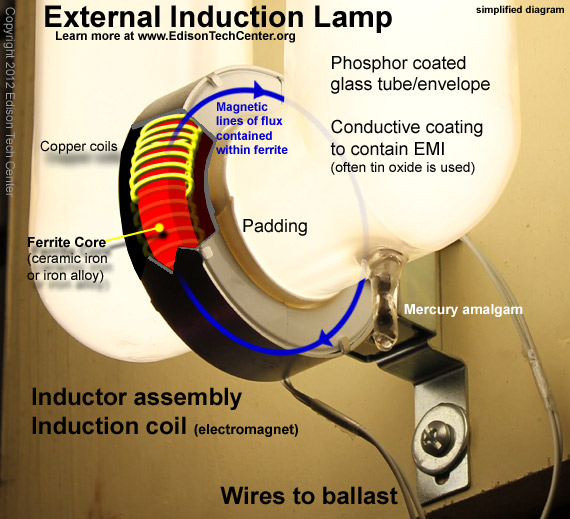 |
|
There may be more than one mercury amalgam, others are called assistant amalgams and are located close to the induction assembly.
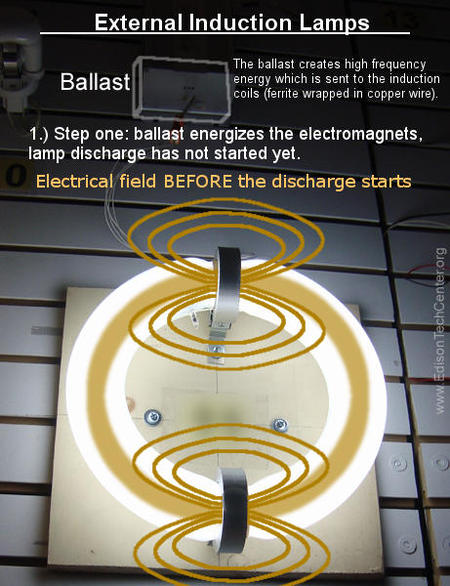 |
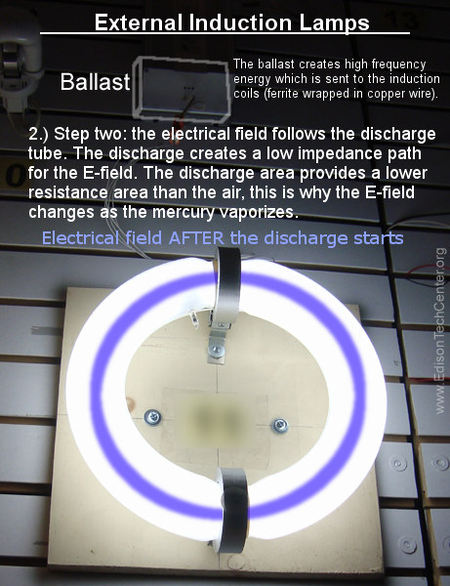 |
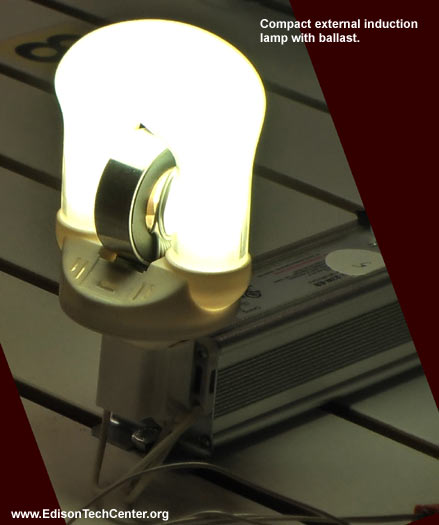 |
|
B.) Internal Induction Lamp - this works on the same principle as the external induction lamp except that the electromagnet is placed inside of the glass bulb. This is typically used when you need a small lamp in a normal household socket.
l
Above: Lifespan is not likely to be 70,000 hours as low cost ballast electronics will likely fail earlier. Smaller induction lamps for household use start at 7 USD as of 2012. Prices will drop and the light may become more popular as an alternative to higher priced LED bulbs. At the time of writing LED units were more expensive to produce than induction lamps, that could change however.
C.) High Efficiency Plasma (HEP)
A new type of induction lamp has been developed called the high efficiency plasma or HEP. The HEP lamp performs at 90 lumens per system watt.
Components: It uses a quartz RF resonator and integral plasma burner with a transition unit and magnetron. The integrated burner use metal halide salts and an inert gas. Microwave energy within the lamp resonates and ionizes the gas, this combines with metal halides to make an intense white light. Read more from its manufacturer Ceravision here.The HEP lamp is a "Plasma Lamp" just like the LEP. The LEP was developed earlier in 2001, it uses a dielectric waveguide made of ceramic. Much of the light was lost in the ceramic waveguide resulting in loss of efficiency. Ceravision changed the design using a clear quartz waveguide which improved the lamp and forms what we call the HEP.
The sulfur lamp is also a plasma lamp. It uses microwave radiation to excite sulfur vapor mixed with argon to create light. 2.45 GHz radiation hits a electrodeless bulb that contains a sulfur powder. You can identify the lamp by a metal screen on the outside of the lamp. The bulb operates at a very high temperature and most models needs a fan for cooling.
The lamp was developed in the 1990s and failed to be a commercial success. It may come back into the public eye as it is improved. Improvements include eliminating the fan. Today the lamp is sold in limited numbers by LG under the name Plasma Lighting System (PLS).
Photo: Wikipedia Commons
Above: J.J. Thomson built various induction lamps to study the electromagnetic field, however his work did not focus on creating consumer products. He is more well known for the discovery of the electron and developments in x-ray/cathode ray tubes.
1884 Johann Wilhelm Hittorf discovers the electrodeless discharge lamp. Hittorf is also known for the discovery of the cathode-ray tube in 1869
Munster, Germany1880s J. J. Thomson thoroughly studies the phenomena of the electrodeless discharge lamp after initial discovery by Johann Wilhelm Hittorf (1884). Thomson like Hittorf is an established physicist. Cambridge, England
1893 Nikola Tesla first demonstrates his electrodeless lamp at the 1893 World Columbian Exposition in Chicago. His lamp looked like a large lightbulb and had strange greenish phosphors. His lamp was powered by the electromagnetic field of a nearby large "Tesla Coil". Tesla brought the lamp into the public eye and further improved the lamp. The industrialist later sued academian J.J. Thomson in order to secure rights to try to make money from it. A practical consumer lamp was never developed.
New York, NY1904 Peter Cooper Hewitt developed an induction lamp that used mercury vapor (like today's lamps). He already had expertise as the inventor of the first commercial mercury vapor lamps. He worked on induction lamps with a sphere shape and double sphere shape, with external induction coils wrapped around the sphere or "waist" of the double sphere. PC Hewitt also developed internal induction lamps. General Electric, New York, NY
1967 John Anderson develops the first reliable electrodeless lamp. The induction lamp moves out of experimental stages and the commercial era of the lamp begins. Later his compact GENURA lamp was released in 1994. Anderson was a professor at Rensselaer Polytechnic Institute and employee of General Electric with 27 patents related to lamp technology. He also advanced regular fluorescent lamps. Read more on Anderson's work.
Schenectady, New York
Photo: Schenectady Museum1990s Philips Corporation (no names available) develops the QL induction lamp series. The lamps operated at 2.65 Mz.
Nederlands1990 Michael Ury, Charles Wood develop the sulfur lamp, the first form of "plasma lamp" which uses microwave energy to energize sulfur in a sealed bulb. The US Department of Energy and Fusion Lighting developed this lamp. The sulfur lamp led to the LEP and HEP lamp later on.
Rockville, Maryland, US2000s Andrew Neate developes the HEP lamp (High Efficiency Plasma). This lamp is a cross between the induction lamp and a metal halide lamp. Ceravision. Also see LEP lamps listed on our metal halide page. Neate developed a quartz waveguide that increases efficiency.
Milton Keynes, United Kingdom
2005 ? at Amko Solara develops the dimmable fluorescent induction lamp which operates at 250 KHz.
Help us complete this history if you know who was the inventor. Contact us.
Note: Osram has its own line called the Endura which operates at 250 kHz
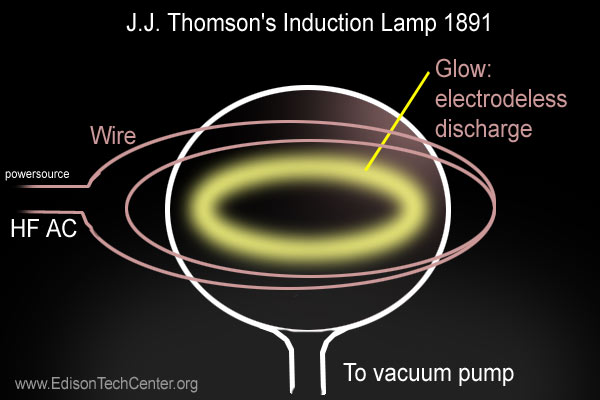
Above: 1891: J.J. Thomson's induction lamp was used to study electromagnetic fields and there was no phosphor on the bulb. Only the circular part of the glass bulb glowed with an arc discharge. Thomson's work set the stage for later inventors like Tesla and Peter Cooper Hewitt. Learn more about J.J. Thomson from the book: J.J. Thomson and the Discovery of the Electron by E.A. Davis and Isobel J. Falconer.
Above: 1893: Tesla demonstrating wireless power transferred through the air by electromagnetic fields created by the Tesla coil in Chicago. His demonstration attracted a lot of attention, however the invention needed a lot of work to become practical. RFI/EMI and severe safety issues were the major problems with wireless lamp power. His use of phosphors in the induction lamp are a lasting contribution to the modern incandescent lamp. Phosphors were first used in regular electrode lamps as early as the 1859 by Alexandre-Edmond Becquerel
Below: 1904 Peter Cooper Hewitt develops both internal and external induction lamps which are the first to use mercury vapor. Mercury is inserted into the spheres, then impurities are removed before sealing the vessel. Below are four different configurations.
Lamps are presented in the order of chronological development
|
Previous: Metal Halide Lamps 1962 |
Congratulations!
you have finished all 12 lamp types.
Donate to keep us
ad-free HERE |
 |
|
Arc
- Incandescent - Nernst
- Neon - Mercury
Vapor - Sodium Lamp - Fluorescent
- Halogen - EL
- LED - MH
- Induction
|
COMMENTS?
Help us edit and add to this page by becoming a ETC volunteer!
Give us feedback
on this and other pages using our Facebook
Page
Written by M.Whelan with additional research by Rick DeLair and Dr. Victor Roberts
Please contact us if you are a historian and wish to correct or improve this document.Sources:
"A Consideration on the electrodeless fluorescent lamp and its radio interference characteristics". Jin-Dam Mok, Sang-Bong Jeon, Seun-Keun Park. IEEE Xplore Digital Library.
Inductionlighting.blogspot.com
Wikipedia
www.Electriciansforum.co.uk Induction Lighting
tzlight.com/technology.html
Britannica.com
Merriam-Webster
home.frognet.net/~ejvcov/anderson
enotes.com
Environmental Aspects of Magnetic Induction Lamps by L. Michael Roberts and Jim Morelli
JJ Thomson and the Discovery of the Electron by I.J. Falconer
Victor Roberts
Photos:
Edison Tech Center
Schenectady Museum
Other photos from the public domain (historical)
US Patent officePhoto/Video use:
Commercial entities must pay for use of photos/graphics/videos in their web pages/videos/publications
No one commercial or public is allow to alter Edison Tech Center photos/graphics/videos.
Educational Use: Students and teachers may use photos and videos for school. Graphics and photos must retain the Edison Tech Center watermark or captions and remain unmanipulated except for sizing.Permissions - Videos: We do not email, FTP, or send videos/graphics to anyone except in DVD form. Payment is needed for this service. See our donate page for pricing, and our catalogue for a listing of videos on DVD.
Professional video production companies may get videos in data form with signed license agreements and payment at commercial rates.
Back
to Home
Copyright
2014 Edison Tech Center

